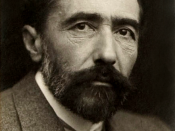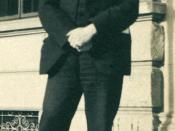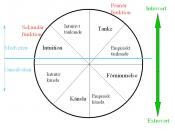"The Lagoon"ÃÂ Throughout the history of civilization, one cannot help but realize the possible existence of a human collective unconscious as proposed by Carl Jung. The human psyche has created an ethereal realm resembling Plato's perfect Forms that categorize the various roles of life into succinct archetypes. These archetypes lay dormant in each person, existing only in a subconscious state, until they are awakened by a stimulus. In "The Lagoon,"ÃÂ Joseph Conrad ingeniously integrates the use of these ancient archetypes into his work so as to better convey his central theme: one cannot expect that fleeing from undeniable discord will resolve the dilemma, but rather, one must realize that cowardly flight will only prompt the conflict to return with a force of greater magnitude, wreaking utter devastation in the unforeseeable future.
The unhealable wound plays an integral role in the proper development of Conrad's theme as Arsat's instinctual flight from his brother's death leads him to a pitiful existence of solitude and regret.
Arsat painfully and remorsefully recollects, "I never turned back. I heard him calling my name again with a great shriek, as when life is going out together with the voice-- and I never turned my head"ÃÂ(Conrad 516). Attempting to flee from his persistent problems, Arsat is eventually led down a path of demise. The somber disposition of the lagoon embodies the idea that Arsat has already perished; his spiritual flame is extinguished as he merely exists in a world "bewitched into an immobility perfect and final"ÃÂ(510). His betrayal of his own flesh and blood brings about his undoing following Diamelen's death as he vows to return home, to return to his brother, and to accept death. As one can easily perceive, Arsat's utter denial of his brother ultimately results in his damnation.
In addition to the unhealable wound, it is essential to realize Conrad's prolific use of the traditional star-crossed lovers archetype apparent in countless works of literary importance to further his crucial theme. When pathetically attempting to deny and flee the Ruler's wrath and indulging in their own basic human desires for pleasure, Arsat and Diamelen are pursued by relentless, prospective murderers. Believing freedom lay in escape, the ill-fated couple is sadly disappointed by the complete and utter desolation awaiting their arrival in the dire lagoon where "the darkness scented and poisonous of impenetrable forests"ÃÂ(Conrad 511) lurks in every corner. The despair reaches a pinnacle when Arsat sadly states, ""ÃÂShe burns no more'"ÃÂ(517). Not only does Arsat's brother perish at the claws of merciless demons, but Diamelen also leaves this cruel world and embarks on a journey to the after-life. One is then led to believe that Arsat will soon join his companions by abandoning the current world and entering the next realm as "he stood lonely in the searching sunshine; and he looked beyond the great light of a cloudless day into the darkness of a world of illusions"ÃÂ(517). Undoubtedly, the protagonist's attempt to flee from fear results in the destruction of everything held dear to him.
Pain is not merely of the physical world, where nature defiantly asserts its dominance through the intricate network of neurons and electrical impulses that inform the human brain of imminent injury. But rather, it is of the mental realm, where Pain has no bound and no master to leash its cold, bitter hatred upon the weary mind. In a masterful attempt at portraying Arsat's internal turmoil, Conrad uses the subtle power of the innate archetype to convey his message of undeniable pain and regret. Thus, society is able to learn and progress through the thoughts and actions of its constituent individuals. By using basic concepts such as the unhealable wound and star-crossed lovers archetypes that exist in the realm of the subconscious, on a level to which humanity can relate and experience, one ensures the proper and complete comprehension of an idea by the masses.





